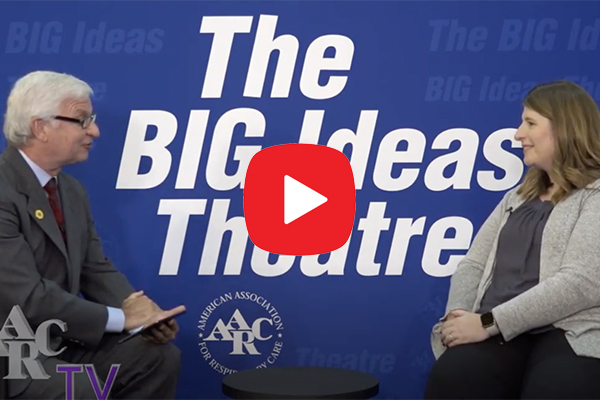
The RIsOTTO Study and Benefit of LTOT
Are you currently evaluating patients hospitalized for COPD exacerbation for long-term oxygen therapy (LTOT) in your daily practice? The odds are unlikely, and perhaps worse is the lack of involvement by respiratory therapists in selecting home oxygen equipment. Based on the recently published RIsOTTO study, 58% of responding respiratory therapists evaluated patients for home oxygen at rest, 43% during activity, and 14% during sleep.1 If you have not read this survey assessing the frequency of respiratory therapists involved in evaluating the need for home oxygen in hospitalized COPD patients, click on this link. Less than half the respiratory therapists surveyed were familiar with CMS home oxygen criteria. Based on these criteria, patients would qualify for home oxygen therapy with an arterial partial pressure of oxygen of 55 mmHg or less or arterial oxygen saturation of 88% or less during rest, exercise, or sleep.2 We need to assess patients with COPD home oxygen needs not only at rest but during exercise and sleep before discharged. Perhaps other clinicians, such as nurses and physicians, are evaluating these patients. It turns out that patients with COPD are only assessed approximately 20% of the time beyond resting saturation.3 This finding is concerning considering the reported survival benefit of home oxygen use in patients with COPD and severe hypoxemia.4,5 Use of home oxygen also improves exercise tolerance and dyspnea in these patients.6,7 We must keep these patients moving. Lower activity levels in patients with COPD were a predictor for more acute exacerbations and hospital readmissions.8,9 Low physical activity level is also a predictor of mortality in these patients.10
Selecting the Appropriate LTOT Device
Since physical activity is essential, does the LTOT device selection matter as long as it is mobile? A survey of individuals with COPD found that perceived satisfaction with their LTOT devices positively impacted their self-reported mobility and quality of life. Their self-reported mean mobility score was higher in the liquid oxygen group than the portable oxygen cylinder or oxygen concentrator groups.11 Due to changes in Medicare laws, liquid oxygen is difficult for patients to obtain. If LTOT devices are too heavy, an individual may lessen their physical activity. They could also feel self-conscious about a device and become less active to avoid people. These LTOT device-related issues may have a significant impact on our patient’s lives. Clinicians involved in the selection of LTOT devices must consider multiple factors. There must also be a coordinated follow-up after a few weeks to ensure that the selected LTOT device is appropriate.
How do we improve the selection of appropriate devices for patients needing LTOT? Just as medication reconciliation occurs with admitted patients usually by hospital pharamacist, respiratory therapists should own the home oxygen reconciliation for patients needing LTOT. Identifying patients needing LTOT before discharge may be the most challenging task. In many acute care hospitals, the nursing staff would place and wean oxygen on the hospital wards and have little time for additional tasks. A morning trial with oxygen turned off during the nurse’s morning assessment would identify patients unable to wean. Adding a checkbox to the electronic medical record that allowed the nurse to check if the patient desaturates off oxygen, could generate a notification sent to the respiratory care department indicating the need for an LTOT evaluation. The electronic medical record could also notify the department if an admitted patient is currently receiving LTOT. Once the notification is received, the respiratory therapist could assess the patient’s need for LTOT at rest, exercise, and sleep. If LTOT is needed, a respiratory therapist could evaluate the patient using a portable oxygen concentrator provided by the patient’s selected homecare company before discharge to ensure that the patient doesn’t desaturate during physical activity. At this time, we could schedule a follow-up appointment within a few weeks of discharge in the outpatient setting to evaluate the patient’s satisfaction with the LTOT device and perform a six-minute walk test.
So, how do we achieve this? Unfortunately, there is a lot of foundational work to complete before respiratory therapists perform home oxygen reconciliation as part of their everyday practice. First and foremost, we need to address respiratory therapists’ knowledge gap of Medicare guidelines, evaluating patients during activity and sleep, and not just rest, and the various available devices used in LTOT. To help, we can conduct a series of workshops or didactic lectures with assessments followed by hands-on training with currently used oxygen cylinders with conserving devices and portable oxygen concentrations throughout the country. This is an effort that the AARC and State affiliates can tackle. For everyone who read the paragraph above and feels you are already doing this, we need to join efforts to obtain data supporting respiratory therapists performing oxygen reconciliation. This data should focus on improved patient outcomes such as reduced hospital readmissions, lower emergency department visits, fewer exacerbations, and enhanced quality of life. There are also potential cost-savings, including decreased health care use and perhaps discontinuing LTOT by identifying patients where oxygen is no longer needed. These assessments can provide some revenue by billing the CPT code for pulse oximetry during exercise. A legislative effort is needed by the respiratory therapists and patients requiring LTOT to support reimbursement for providing patient education and LTOT device training in addition to the routine oxygen saturation assessments.
Time to Act as a Profession
Home oxygen reconciliation is an area of practice where respiratory therapists could impact patient outcomes in outpatient and acute care settings. This practice area could improve LTOT patient’s quality of life and help reduce their health care needs. The RIsOTTO study has provided a basic needs assessment upon which the profession can build. Now is the time for us to act on this opportunity as a profession.
References
- Tan AM, Vines DL, Krishnan JA, Prieto-Centurion V, Kallstrom TJ. Home oxygen evaluation by respiratory therapists in patients hospitalized for COPD exacerbations: The RIsOTTO study. Respir Care 2020, doi:10.4187/respcare.07628, 10.4187/respcare.07628
- National Coverage Determination (NCD) for Home Use of Oxygen (240.2). Centers for Medicare & Medicaid Services. https://cms.gov/medicare-coverage-database/details/ncd-details.aspx?NCDId=169.
- Zaidi F, Lee RS, Buchcic BA, Bracken NE, Jaffe HA, Joo M, et al. Evaluation and documentation of supplemental oxygen requirements is rarely performed in patients hospitalized with COPD. Chronic Obstr Pulm Dis 2017;4(4):287-296.
- Long term domiciliary oxygen therapy in chronic hypoxic cor pulmonale complicating chronic bronchitis and emphysema. Report of the Medical Research Council Working Party. Lancet 1981;1(8222):681- 686.
- Nocturnal Oxygen Therapy Trial Group. Continuous or nocturnal oxygen therapy in hypoxemic chronic obstructive lung disease: a clinical trial. Ann Intern Med 1980;93(3):391-398.
- Eaton T, Garrett JE, Young P, Fergusson W, Kolbe J, Rudkin S, Whyte K. Ambulatory oxygen improves quality of life of COPD patients: a randomised controlled study. Eur Respir J 2002;20(2):306- 312.
- O’Donnell DE, D’Arsigny C, Webb KA. Effects of hyperoxia on ventilatory limitation during exercise in advanced chronic obstructive pulmonary disease. Am J Respir Crit Care Med 2001;163(4):892-898.
- Moy ML, Teylan M, Weston NA, Gagnon DR, Garshick E. Daily step count predicts acute exacerbations in a US cohort with COPD. PLoS One 2013;8(4):e60400. 17. Nguyen HQ, Chu L,
- Amy Liu IL, Lee JS, Suh D, Korotzer B, et al. Associations between physical activity and 30-day readmission risk in chronic obstructive pulmonary disease. Ann Am Thorac Soc 2014; 11(5):695-705.
- Waschki B, Kirsten A, Holz O, Muller K, Meyer T, Watz, H, Magnussen H. Physical activity is the strongest predictor of all-cause mortality in patients with COPD: a prospective cohort study. Chest. 2011;140(2):331-342. doi:10.1378/chest.10-2521
- Mussa C, Tonyan L, Yi-Fan C, Vines, DL. Perceived Satisfaction with Long-term Oxygen Delivery Devices Affects Perceived Mobility and Quality of Life of Oxygen-Dependent Individuals with COPD. Respir Care. 2018, 63(1) 11-19.
Email newsroom@aarc.org with questions or comments, we’d love to hear from you.














